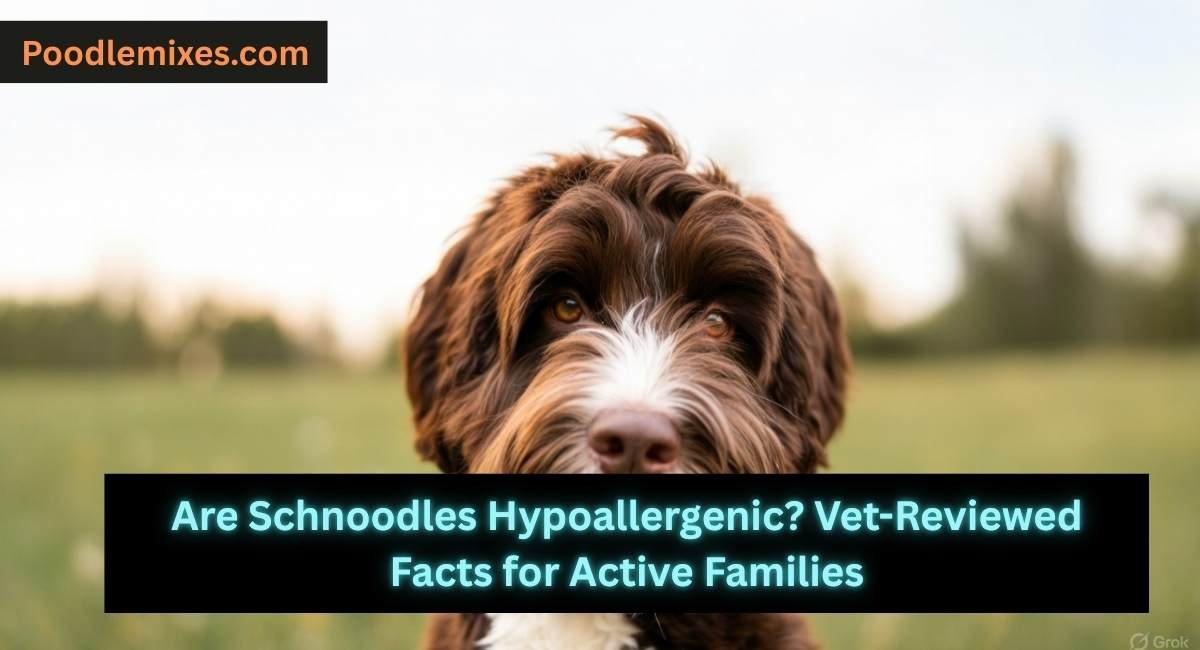Are Schnoodles hypoallergenic? This intelligent and spirited cross between a Schnauzer and a Poodle combines two of the most recommended breeds for allergy sufferers. With a reputation for being low-shedding and intelligent, the Schnoodle seems like an ideal choice. But it’s important to start with the definitive statement from experts like the American College of Allergy, Asthma, and Immunology: no dog breed is completely hypoallergenic. While Schnoodles are often an excellent match for those with sensitivities, their suitability depends on understanding their specific coat genetics and care requirements. This guide will explore the reality of living with a Schnoodle when you have allergies.
Are Schnoodles Hypoallergenic?
No, Schnoodles are not fully hypoallergenic, but they are widely considered one of the most reliable hypoallergenic mixed breeds. This strong reputation comes from both parent breeds—Schnauzers and Poodles—being single-coated, low-shedding dogs. Since they lack an undercoat, they don’t experience seasonal “blowing” of fur, which significantly reduces the amount of dander released into your home. However, as the American Lung Association clarifies, allergens are proteins in dander, saliva, and urine. So, while a Schnoodle may shed very little, it still produces these allergens, making it low-shedding and allergy-friendly, but not allergen-free.

What Does Hypoallergenic Really Mean in Dogs?
The term “hypoallergenic” can create false expectations. In veterinary terms, it means “less likely” to cause an allergic reaction, not “will not cause” one. The American Kennel Club (AKC) classifies both Schnauzers and Poodles as hypoallergenic because of their wiry or curly, non-shedding coats that trap dander.
However, scientific evidence provides crucial context. A study in the Journal of Allergy and Clinical Immunology found that homes with “hypoallergenic” dogs did not have significantly lower levels of the common dog allergen Can f 1. This reinforces that individual dog variability and a person’s specific sensitivity are more critical factors than the breed label alone.
Schnoodle Coat Types and Allergen Impact
A Schnoodle’s coat can vary, inheriting the Poodle’s tight curls, the Schnauzer’s wiry texture, or a soft, wavy blend. This texture directly influences grooming needs and allergen control.
The following chart outlines the common Schnoodle coat variations:
| Coat Type | Shedding Level | Dander Control | Allergy Risk (Relative) |
|---|---|---|---|
| Curly (Poodle-Dominant) | Very Low | Excellent | Lower |
| Wiry (Schnauzer-Dominant) | Very Low | Excellent | Lower |
| Wavy/Soft (A Balanced Mix) | Low | Very Good | Low |
As VCA Animal Hospitals notes, both curly and wiry coats are highly effective at trapping dander close to the skin. The wiry Schnauzer coat, in particular, requires regular grooming to maintain its texture and continue trapping dander effectively. This makes the Schnoodle a relatively predictable and excellent choice for allergy management.
Allergy Considerations for Schnoodle Owners
The Schnoodle’s suitability depends on the severity of your allergies and the specific coat of the dog. Their range in size (from Toy to Standard) means that larger Schnoodles will have more skin surface area and thus potentially produce more dander than smaller ones.
According to the National Institutes of Health (NCBI), allergen production is highly individual. For people asking “are Schnoodles hypoallergenic,” the answer is overwhelmingly positive, but caution is still advised. Their consistent low-shedding nature from both parents makes them a safer bet than many other mixes, but spending time with the specific dog is the ultimate test.
Tips to Reduce Allergic Reactions With a Schnoodle
Proactive grooming is the key to success with a Schnoodle. Their non-shedding coat requires regular maintenance to prevent mats and control dander.
- Commit to Professional Grooming: Schnoodles need grooming every 4-6 weeks. Whether you prefer a curly “teddy bear” clip or a wiry “Schnauzer” cut, regular trims are essential. The AKC highlights that proper grooming is critical for non-shedding breeds to maintain skin and coat health.
- Frequent Brushing: Brush your Schnoodle at least twice a week to prevent mats, which can trap dander and moisture against the skin.
- Regular Bathing: Bathe your dog every 3-4 weeks with a gentle shampoo to wash away allergens. Pay special attention to their beard, which can trap food and saliva.
- Focus on Hygiene: Wipe your Schnoodle’s beard after eating and drinking to remove saliva, a common allergen source.
- Environmental Control: Use a HEPA air purifier and vacuum with a HEPA filter regularly. The EPA recommends these measures for reducing indoor allergens.
Other Poodle Mixes Often Considered “Hypoallergenic”
Schnoodles are a standout in the Doodle category due to both parents being hypoallergenic. Here’s a comparison:
| Breed | Typical Coat | Shedding Level | Allergy Friendliness* |
|---|---|---|---|
| Schnoodle | Wiry/Curly | Very Low | Very High |
| Havapoo | Wavy/Curly | Very Low | Very High |
| Goldendoodle | Curly/Wavy | Low–Moderate | Moderate |
| Sheepadoodle | Curly/Wavy/Shaggy | Low–High (varies) | Moderate (varies) |
*Friendliness = relative chance of being allergy-manageable. Schnoodles rank very high due to predictable low-shedding genetics.
FAQ Section (People Also Ask)
Do Schnoodles shed a lot?
No, Schnoodles are very low-shedding dogs. They are one of the least shedding mixed breeds available because both Schnauzers and Poodles are single-coated, non-shedding breeds.
Are Schnoodles good for people with severe allergies?
They are one of the best breeds to consider. The combination of two hypoallergenic parents makes them a more predictable and reliable choice than mixes with a shedding parent breed. However, individuals with severe allergies should still spend time with the specific dog and consult their allergist.
Is a wiry or curly coat better for allergies?
Both are excellent for controlling dander. A curly Poodle coat is well-known for trapping allergens. A wiry Schnauzer coat is equally effective but requires regular stripping or clipping to maintain its texture and dander-trapping properties. The most important factor is consistent grooming.
Conclusion
So, are Schnoodles hypoallergenic? In the strictest sense, no dog is. However, the Schnoodle is arguably one of the most dependable mixed breeds for allergy sufferers due to its lineage from two proven hypoallergenic parents. Their low-shedding, dander-trapping coat makes them a manageable and wonderful companion for many with sensitivities. The commitment to a structured grooming routine is essential for success. By choosing a reputable breeder, spending time with your potential pet, and maintaining a clean home, you can confidently welcome a Schnoodle into your life.
